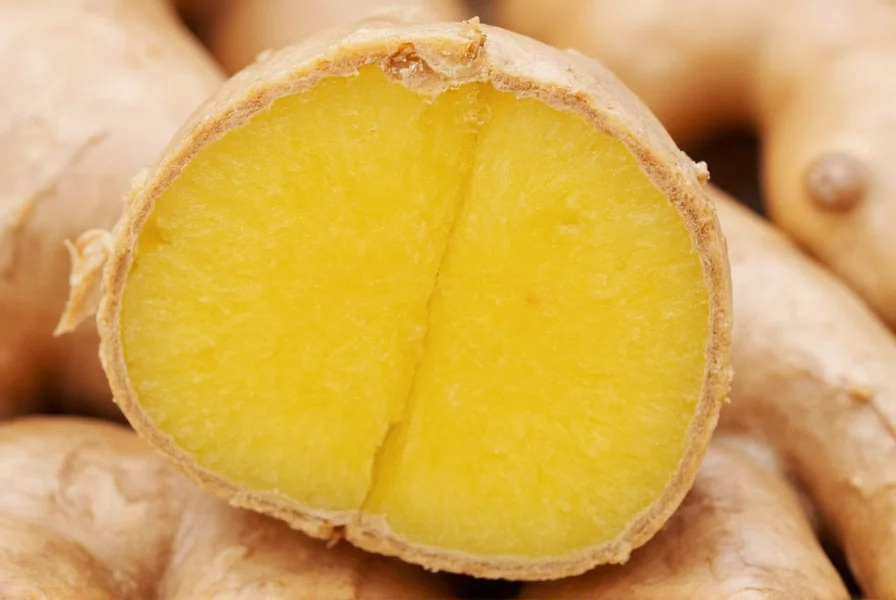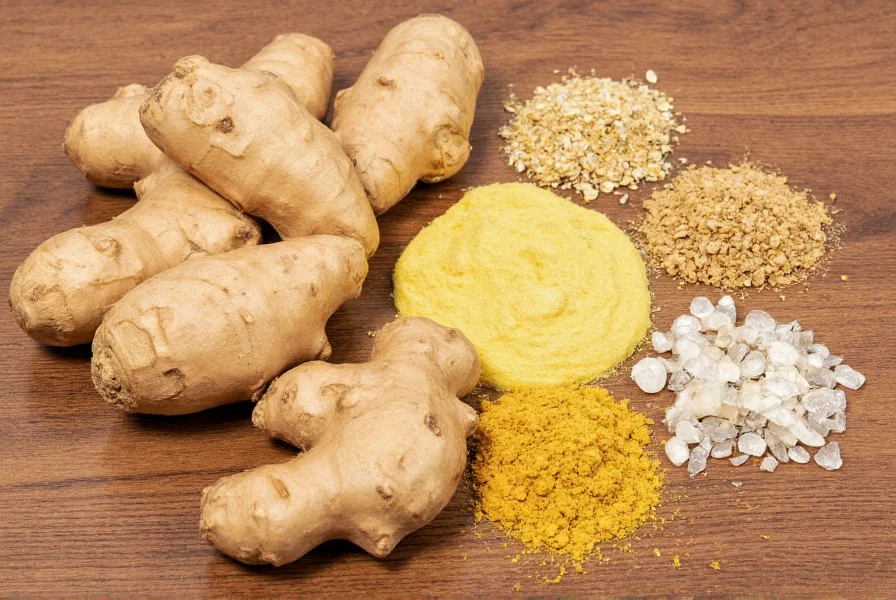Ginger isn't just a flavorful spice—it's a nutritional powerhouse with centuries of medicinal use. This knotted rhizome delivers more than just zesty flavor to your dishes; it provides essential nutrients and bioactive compounds that support overall wellness. While ginger shouldn't be considered a primary source of vitamins and minerals due to typical small serving sizes, its concentrated beneficial compounds make it a valuable dietary component.
Comprehensive Nutritional Profile of Ginger
Understanding ginger's complete nutritional composition requires examining both its basic macronutrients and its unique phytochemical profile. The following table details the nutritional value of raw ginger per 100 grams, based on USDA FoodData Central data:
| Nutrient | Amount per 100g | % Daily Value* |
|---|---|---|
| Calories | 80 kcal | 4% |
| Carbohydrates | 17.77 g | 6% |
| Dietary Fiber | 2.0 g | 7% |
| Sugars | 1.7 g | - |
| Protein | 1.82 g | 4% |
| Total Fat | 0.75 g | 1% |
| Vitamin C | 5.0 mg | 8% |
| Magnesium | 43 mg | 11% |
| Potassium | 415 mg | 9% |
| Manganese | 0.229 mg | 10% |
*Percent Daily Values are based on a 2,000 calorie diet. Your daily values may be higher or lower depending on your calorie needs.
Key Bioactive Compounds in Ginger
What truly distinguishes ginger nutritionally are its bioactive compounds, particularly gingerols—the pungent substances responsible for ginger's characteristic flavor and many health benefits. These compounds demonstrate:
- Anti-inflammatory properties that may help reduce muscle pain and soreness
- Antioxidant effects that combat oxidative stress in the body
- Digestive benefits including relief from nausea and improved gut motility
- Cardiovascular support through potential blood pressure regulation
Research published in the Journal of Agricultural and Food Chemistry indicates that fresh ginger contains approximately 0.5-1.5% gingerol by weight, with higher concentrations found in younger rhizomes. When ginger is dried or cooked, gingerol transforms into shogaols, which are even more potent but present in smaller quantities.

Practical Serving Sizes and Nutritional Impact
While the 100g nutritional data provides a comprehensive view, most people consume ginger in much smaller quantities. Here's how typical serving sizes translate to nutritional intake:
- 1 teaspoon fresh ginger (2g): 1.6 calories, 0.36g carbohydrates, trace amounts of magnesium and potassium
- 1 tablespoon fresh ginger (6g): 4.8 calories, 1.1g carbohydrates, 0.1g protein, 1% DV magnesium, 1% DV potassium, 2% DV manganese
- 1/4 teaspoon ground ginger (0.5g): 1.1 calories, 0.26g carbohydrates, minimal micronutrients
Though these serving sizes don't provide substantial amounts of vitamins and minerals, they deliver meaningful quantities of bioactive compounds. For example, 2g of fresh ginger contains approximately 10-30mg of gingerols, which studies suggest is sufficient to provide therapeutic benefits for nausea relief and inflammation reduction.
Health Benefits Supported by Research
The nutritional value of ginger extends beyond basic vitamins and minerals to include significant health-promoting properties:
Digestive Health Support
Ginger stimulates saliva, bile, and gastric enzyme production, facilitating digestion. A systematic review in Nutrients found that ginger significantly accelerates gastric emptying, reducing symptoms of indigestion. The same review noted ginger's effectiveness in reducing nausea from pregnancy, chemotherapy, and post-surgery recovery.
Inflammation Reduction
Ginger's anti-inflammatory properties make it valuable for managing chronic inflammatory conditions. Research in Arthritis demonstrated that ginger extract reduced pain and stiffness in osteoarthritis patients. The mechanism appears to involve inhibition of inflammatory cytokines and enzymes like COX-2.
Antioxidant Protection
The gingerol compounds in ginger function as potent antioxidants, neutralizing free radicals that cause cellular damage. A study in Food Chemistry showed ginger extract had higher antioxidant capacity than many common fruits and vegetables when measured by ORAC (Oxygen Radical Absorbance Capacity) values.

Incorporating Ginger into Your Diet
Maximizing the nutritional benefits of ginger requires understanding how preparation methods affect its bioactive compounds:
- Fresh ginger: Highest in gingerols; best for anti-nausea effects. Grate or slice into teas, stir-fries, or smoothies
- Dried ginger powder: Contains more shogaols; better for anti-inflammatory effects. Use in baking or spice blends
- Cooked ginger: Partial conversion of gingerols to shogaols; balances both benefits. Add to soups and stews
- Fermented ginger: Enhanced bioavailability of compounds; try homemade ginger beer or kimchi
For maximum nutritional retention, add fresh ginger toward the end of cooking. Prolonged heat exposure degrades gingerols, though it creates beneficial shogaols. Consuming ginger with black pepper may enhance absorption of its active compounds due to piperine's effect on bioavailability.
Considerations and Potential Side Effects
Ginger is generally safe for most people when consumed in typical food amounts. However, certain considerations apply:
- People taking blood-thinning medications should consult their doctor before consuming large amounts of ginger
- Those with gallstones should use ginger cautiously as it may increase bile production
- Excessive consumption (more than 4g daily) may cause heartburn or mouth irritation in some individuals
- Pregnant women should limit intake to 1g daily unless otherwise directed by a healthcare provider
Unlike many supplements, ginger's safety profile is excellent at culinary doses. The European Medicines Agency classifies ginger as generally safe when used appropriately, with no significant drug interactions at typical dietary consumption levels.
Comparing Ginger to Similar Spices
When evaluating the nutritional value of ginger root, it's helpful to compare it with related spices:
- Ginger vs Turmeric: Both contain potent anti-inflammatory compounds (gingerols vs curcumin), but turmeric requires fat and black pepper for optimal absorption, while ginger's compounds are more readily bioavailable
- Ginger vs Garlic: Garlic provides more significant cardiovascular benefits through allicin, while ginger excels at digestive support and nausea relief
- Ginger vs Cinnamon: Cinnamon has stronger blood sugar regulating effects, while ginger offers superior anti-nausea properties
Combining these spices often creates synergistic effects, as seen in traditional Ayurvedic and Traditional Chinese Medicine formulations.
Conclusion: The True Value of Ginger Nutrition
The nutritional value of ginger extends far beyond its modest vitamin and mineral content. Its true worth lies in the potent bioactive compounds that provide significant health benefits even in small culinary amounts. While ginger shouldn't replace primary sources of essential nutrients, its inclusion in a balanced diet contributes valuable anti-inflammatory, antioxidant, and digestive-supporting properties. Understanding how different forms of ginger affect its nutritional profile allows you to maximize its health benefits based on your specific needs.
Frequently Asked Questions
How much ginger should I consume daily for health benefits?
For general health benefits, 1-3 grams of fresh ginger daily (about 1/2 to 1.5 tablespoons grated) provides sufficient bioactive compounds. Studies showing therapeutic effects typically use 1-2 grams daily. Higher amounts up to 4 grams may be used short-term for specific conditions like nausea, but consult a healthcare provider for prolonged high-dose use.
Does cooking ginger reduce its nutritional value?
Cooking transforms but doesn't eliminate ginger's beneficial compounds. Heat converts gingerols to shogaols, which are more potent anti-inflammatories but less effective for nausea relief. For maximum gingerol retention, add fresh ginger toward the end of cooking. The overall nutritional value remains high regardless of preparation method, just with different therapeutic profiles.
Is fresh ginger more nutritious than dried ginger powder?
Both forms offer nutritional benefits with some differences. Fresh ginger contains higher levels of gingerols (better for nausea relief), while dried ginger has more shogaols (stronger anti-inflammatory effects). Weight for weight, dried ginger is more concentrated, but typical serving sizes of powder are smaller. Neither is 'better'—they provide complementary benefits depending on your health goals.
Can ginger help with weight loss?
Ginger may support weight management through several mechanisms: it can increase thermogenesis (calorie burning), improve digestion, and potentially reduce inflammation associated with obesity. A review in 'Obesity Reviews' found ginger supplementation led to modest reductions in body weight and waist-to-hip ratio. However, ginger alone won't cause significant weight loss—it works best as part of a comprehensive healthy eating and exercise plan.
What's the best way to preserve ginger's nutritional value during storage?
To maximize ginger's shelf life and nutritional retention: store unpeeled ginger in an airtight container in the refrigerator (lasts 3-4 weeks), freeze whole pieces (maintains potency for 6 months), or store in vodka (preserves compounds for months). Avoid storing at room temperature for extended periods, as this accelerates degradation of gingerols. For best results, freeze ginger and grate it frozen when needed.










 浙公网安备
33010002000092号
浙公网安备
33010002000092号 浙B2-20120091-4
浙B2-20120091-4